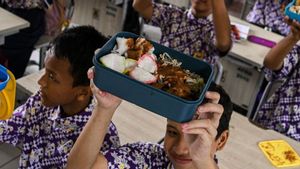JAKARTA - The World Health Organization (WHO) said pneumonia killed 740,180 children under the age of 5 years in 2019, accounting for 14 percent of all deaths of children under five years old, and 22 percent of all deaths in children aged 1 to 5 years.
Pneumonia, a disease that attacks the human lungs can affect anyone, including children. Streptococcus pneumoniae bacteria, Haemophilus influenzae type b (Hib) and respiratory syncytial virus enter through the breath or by aspiration (inhaled) by accident, then trigger the body's immune response and cause an inflammatory reaction.
Pediatrician at the University of Indonesia Hospital (RSUI), dr. Cynthia Centauri, Sp.A revealed, in 2017 Indonesia had occupied the seventh position in the world as the country with the highest pneumonia cases.
A number of things, including low immunity such as due to lack of nutrition, dense housing, low economic status, previous accompanying diseases such as HIV and measles, air pollution, cigarette smoke and incomplete immunization, are said to be risk factors for a person to get this disease.
Those especially children with pneumonia generally feel symptoms and signs such as coughing, shortness of breath characterized by rapid breathing, chest indrawing, nostril breathing, blue appearance, decreased oxygen saturation. Rapid breathing in children can be done by measuring the respiratory rate in one minute.
Other symptoms that commonly arise include difficulty eating and drinking, decreased consciousness marked by sleeping more or looking weak, fever or hypothermia, seizures, additional breath sounds, and other accompanying symptoms such as diarrhea, vomiting and so on.
Those with these symptoms can be hospitalized, especially if they have difficulty breathing or whimpering, have decreased oxygen saturation, have difficulty eating, or have comorbidities.
Basically, pneumonia has a degree, like any disease in general, which starts from mild which is characterized by the condition of the child being still active, still able to eat and drink, but breathing is rather fast and has a mild fever. In this condition the child can still be taken outpatient to the doctor. Meanwhile, in severe degrees, marked by heavy breathing, the child is unable to eat and drink, is weak, if this condition occurs, immediately take him to the nearest Emergency Room (IGD).
According to Cynthia, the thing that parents need to pay attention to is if the child is experiencing shortness of breath, namely not giving them anything to eat or drink, to prevent them from choking and lead to aggravating the child's condition.
Prevent pneumonia

Pneumonia is a disease that can be prevented and treated. Increasing pneumonia prevention efforts could prevent nearly nine million child deaths from pneumonia and other major diseases by 2030.
Preventing pneumonia in children can be done through providing adequate nutrition to increase the child's natural defenses and can start with exclusive breastfeeding for the first 6 months of life, complete immunizations, and good nutrition.
Other prevention efforts that are addressing environmental factors such as indoor air pollution (by providing affordable clean indoor stoves, for example) and promoting good hygiene in crowded homes also reduce the number of children falling ill with pneumonia.
On the other hand, Pediatrician at the University of Indonesia Hospital (RSUI), dr. Nina Dwi Putri, Sp.A(K), MSc.(TropPaed) views the importance of immunization in an effort to prevent pneumonia.
He explained, in principle, immunization can protect the body from the risk of severe infection, done by being given or infected with germs that have been killed or weakened.
By being given immunizations, it is as if the body has an infection and learns to deal with infection, so that it is more prepared when exposed to real germs. Nina emphasized that immunization is the right of every child that is needed in his life.
"Vaccination has the benefit of increasing the immune system of children who are susceptible to contracting diseases, preventing children from contracting certain diseases, and improving children's quality of life," said Nina.
The pneumonia vaccine can be given to infants, children, adults, and the elderly. According to the United States Centers for Disease Control and Prevention (CDC), this vaccine has an effectiveness rate of up to 96 percent in terms of protecting children from pneumonia.
Speaking of side effects, children are generally found to be fussy, tired, decreased appetite, redness, swelling, or pain at the injection site, fever, chills and headache.
However, according to Nina, this is better than unvaccinated children, which can place them easily exposed to infectious diseases, experience a decrease in quality and life expectancy, risk transmitting disease to those closest to them, contracting diseases that arise and their complications so that it can increase the financial burden.
During the COVID-19 pandemic, routine vaccinations for children can still be carried out according to schedule. However, if you are late, you can take part in the Pursuit Immunization Program, which is an activity to provide immunizations to infants and toddlers who have not received a dose of vaccine according to the age specified in the national immunization schedule.
The importance of vaccination, especially during this pandemic, because vaccination can improve the immune system of children who are vulnerable to exposure to infectious agents during the COVID-19 pandemic.
Vaccination also reduces the risk of co-infection or concurrent infection between SARS-CoV-2 infection with other pathogenic infections such as bacteria, viruses, fungi, and others.
"Currently cases of concurrent infection have emerged, and it turns out that this pneumococcal coinfection often occurs together with COVID-19 in addition to influenza and Mycoplasma viruses," said Nina.
So that children are not afraid or feel uncomfortable when vaccinating, there are a number of ways that can be applied, including giving them sweet liquids, giving breast milk for children who are still breastfeeding, to calming children by bringing toys or distracting children with other things.
The English, Chinese, Japanese, Arabic, and French versions are automatically generated by the AI. So there may still be inaccuracies in translating, please always see Indonesian as our main language. (system supported by DigitalSiber.id)













